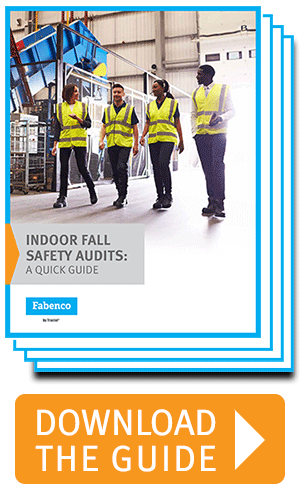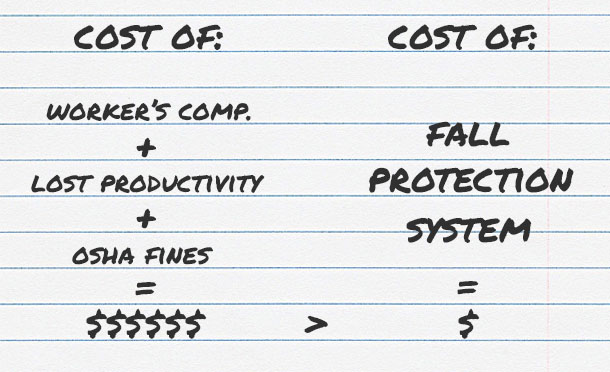
Workplace accidents and injuries have a dramatic impact on your employees’ physical, emotional and financial well-being. And companies are held financially responsible for injured employees while they are unable to work. As a facility or safety manager, you know that investing in safety gates, guardrails and other work safety equipment is a necessity. However, it’s often difficult to convince executives or financial officers to commit to an investment in new safety equipment or training – unless you’re able to speak their language. They want to know how they’ll recover any investment they make and how it will affect the company’s bottom line in the future. That means they need to know the potential costs associated with workplace injuries along with other expenses, such as OSHA fines and lost production.
Calculating Injury Costs
You’re not able to predict when an accident will happen in your facility, how bad it will be, and how much it will ultimately cost the company. Trying to convince your boss to make an investment in loading dock safety gates, for example, before an accident happens can be difficult, but it’s certainly possible. You can start by showing him the potential costs of an injured worker. They go well beyond worker’s comp.
Unfortunately, it’s difficult to come up with hard numbers for this exercise. Think of calculating the risk of injuries that haven’t happened; it’s a bit like guessing what the weather will be like two months from today. Based on historical data, you can come up with a general idea of what will happen in the future. While you may never have had an accident involving an employee falling from heights, statistically, falls are the most prevalent cause of injuries and deaths across all industries. Using that kind of data, you have to assume that without proper fall protection, an injury is likely to happen. Then, look at the average costs associated with those types of accidents and the ripple effects an injury can have, and you can show the leaders of your company the value of investing in workplace safety.
-
Cost #1 – Direct Compensation

-
Cost #2 – The Ripple Effect
When someone gets hurt on the job, it affects everyone in the company. It is difficult to lose an employee – even temporarily – especially a hard worker who is well liked in the organization. It has a negative impact on productivity, lowers employee morale, and increases absenteeism. That means your department can fall behind, putting the rest of the facility on hold until your team is able to catch up. You’ll also have to recruit and onboard new or temporary employees and take reputation into account.
A negative perception of the company can impede your recruitment of skilled talent. What’s more, a poor safety record can turn customers and potential business partners away, as they’ll likely not want to be associated with a dangerous workplace. While it’s impossible to calculate these costs in hard numbers without knowing the details, all of these things add up. The ripple effect can end up affecting your company’s bottom line much more than even the highest worker’s compensation payment.
-
Cost #3 – OSHA Fines
Anytime there’s an accident at your workplace, there will be an OSHA investigation to determine what happened and whether safety regulations were followed. Serious work safety violations result in OSHA fines and penalties of $12,934 per incident. Inadequate or missing safety gates and rails are just one example of OSHA violations. Once discovered, the problem must be solved within a set timeframe, or a Failure to Abate fee of $12,934 per day beyond the abatement date is also imposed. What’s more, if the company willfully engages in dangerous practices, or is a repeat offender, the cost rises dramatically to $129,336 per violation. Most likely, your company leaders will want to do anything to avoid receiving OSHA fines and having to complete the paperwork surrounding an investigation. It’s not only expensive, but it’s a hassle that takes time away from other important work.
Calculating ROI
As you can see, the costs associated with a workplace injury can vary widely. That’s why it’s so hard to quantify the return on investment for work safety. Installing a mezzanine gate or providing safety training to employees, for example, reduces injuries, but the only way to show a return on that investment is by using hypothetical figures based on statistics. The positive return comes not only from money saved but also from employees who feel safe on the job and are thus more focused, engaged, productive, and loyal to the company. In addition, a spotless safety record is attractive to potential applicants, customers, investors, and suppliers alike. Committed employees and a solid reputation increase the likelihood that the business will remain competitive and profitable. This ROI, while not a hard number, is well beyond the hard costs of fall protection systems and other safety measures.
Convincing the Decision Makers
You know that providing adequate work safety for your employees is the right thing to do, both for them and for the company. Convincing higher-ups, who are focused on keeping costs down and profits high, however, to invest in things like loading dock safety gates or a mezzanine gate may take a bit of work. You have to show what the potential risk factors are and how investing in training and safety equipment would minimize that risk. Use the costs and values described in this article to show how every dollar that is invested in safety reduces those risks. There is, in fact, a sizable return on investment. Investing in the safety of employees is one of the soundest financial investments a company can make, both in terms of cost avoidance and an improved work environment.
If you need a bit more ammunition, mention that providing safety training and installing passive fall protection like safety gates and other safety equipment improves the company’s reputation. You need skilled workers to remain competitive and agile. And prospective employees want to know the company they work for cares about their safety and well-being. Plus, current employees will feel better about their jobs, be more engaged in their work, and more likely to remain with the company. All of those things mean lowered costs over time in other areas, like recruitment and new employee onboarding costs.
Show your boss what the company has to gain from investing in workplace safety, and you’ll have an easier time getting the investment you need.





